July 27 – August 13, 2024
A small group of American pilgrims has embarked on a transformative journey along the Saint Lawrence River in Québec, a route that links a series of shrines deep in the Christian history of the region. July 27 to August 13, 2024, join us as we explore the lives, history, and culture of Saints and shrines of the last 350 years.
Saints from the Catholic History of Canada
St Marie of the Incarnation, OSU (28 October 1599 – 30 April 1672) was a French Ursuline nun. As part of a group of nuns sent to New France (Québec) to establish the Ursuline Order, Marie was crucial in the spread of Catholicism in New France. She was a religious author and has been credited with founding the first girls’ school in the New World. Due to her work, the Catholic Church declared her a saint, and the Anglican Church of Canada celebrates her with a feast day. Her tomb is at the Centre Marie-de-l’Incarnation in Québec.
St. Marguerite Bourgeoys, CND (17 April 1620 – 12 January 1700), was a French religious sister and founder of the Congregation of Notre Dame of Montreal in the colony of New France, now part of Québec, Canada. Born in Troyes, she became part of a sodality, ministering to the poor from outside the convent. She was recruited by the governor of Montreal to set up a convent in New France, and she sailed to Fort Ville-Marie (now Montreal) by 1653. There she developed the convent. She and her congregation educated young girls, the poor, and children of First Nations until shortly before her death in early 1700. She is significant for developing one of the first non-cloistered religious communities in the Catholic Church. Declared “venerable” by the pope in 1878, she was canonized in 1982 as the first woman saint of Canada.
St. Francis-Xavier de Montmorency-Laval, commonly referred to as François de Laval (30 April 1623 – 6 May 1708), was a French Catholic prelate who served as Apostolic Vicar of New France from 1658 to 1674 and as Bishop of Québec from its creation in 1674 until he retired due to poor health in 1688. He continued to work in New France until his death in 1708. Among his accomplishments was the founding of the Séminaire de Québec in 1663. Laval was a member of the Montmorency family, but renounced his rights as heir so he could pursue his ecclesiastical career. His tomb is in the Basilica-Cathedral in Québec.
Bl Catherine de Saint-Augustin (3 May 1632 – 8 May 1668) was born in Normandy, France as Catherine de Longpré and was touched at a very early age by divine grace. In her 12th year, she received the call to give herself totally to God and entered the monastery of the Augustinian Hospitaller nuns at Bayeux, France. She took the name of Catherine de Saint-Augustin. Four years later, she was called to help the small communities of Augustinian nuns already settled in Québec since 1639. She arrived in Québec on 19 August 1648, in what she called “her little heaven of Québec” which she wholeheartedly adopted. She took great care of the poor and the sick of her new country at the Hôtel-Dieu hospital of Québec. Her tomb is at the Centre Catherine de Saint-Augustin in Québec.
St Kateri Tekakwitha informally known as Lily of the Mohawks (1656 – April 17, 1680), is a Mohawk Catholic saint and virgin. Born in the Mohawk village of Ossernenon, in present-day New York, she contracted smallpox in an epidemic; her family died and her face was scarred. She converted to Catholicism at age nineteen. She took a vow of perpetual virginity, left her village, and moved for the remaining five years of her life to the Jesuit mission village of Kahnawake, just south of Montreal. She was beatified in 1980 by Pope John Paul II and canonized by Pope Benedict XVI at Saint Peter’s Basilica on 21 October 2012.
St. Marguerite d’Youville, SGM (October 15, 1701 – December 23, 1771) was a French Canadian widow who founded the Sisters of Charity of Montreal, commonly known as the “Grey Nuns”. She was canonized by Pope John Paul II in 1990, becoming the first native-born Canadian to be declared a saint.
St André Bessette, C.S.C. (born Alfred; 9 August 1845 – 6 January 1937), commonly known as Brother André (French: Frère André) and since his canonization as Saint André of Montreal, was a lay brother of the Congregation of Holy Cross and a significant figure of the Catholic Church among French-Canadians. He is credited with thousands of reported healings associated with his pious devotion to Saint Joseph. Bessette was declared venerable in 1978 and was beatified by Pope John Paul II in 1982 Pope Benedict XVI approved the decree of sainthood for Bessette on 19 February 2010, with the formal canonization taking place on 17 October 2010. He is the first Canadian living after Confederation to be canonized.
Religious Sites along the Way
Saint Joseph’s Oratory (Oratoire Saint-Joseph), the largest church in Canada, was founded in 1904 by St André Bessette, CSC in honor of his patron saint, Saint Joseph. The Oratory is the product of numerous architects and thousands of workers in a process spanning six decades. With its monumental scale, Renaissance Revival facade and contrasting Art Deco interior, the Oratory is recognizable not just in Montreal but around the world, attracting more than 2 million visitors and pilgrims to its steps each year. Of interest, the Basilica is astronomically oriented so that the main steps, center aisle, and altar cross are illuminated at sunset on the summer solstice.
Notre-Dame Basilica de Montréal (French: Basilique Notre-Dame) is a minor basilica of the Catholic Church in the historic Old Montreal district of Montreal in Québec, Canada. It is situated next to the Saint-Sulpice Seminary and faces the Place d’Armes square. The interior of the church is amongst the most dramatic in the world and regarded as a masterpiece of Gothic Revival architecture. The vaults are coloured deep blue and decorated with golden stars, and the rest of the sanctuary is decorated in blues, azures, reds, purples, silver, and gold. It is filled with hundreds of intricate wooden carvings and several religious statues. Unusual for a church, the stained glass windows along the walls of the sanctuary do not depict biblical scenes, but rather scenes from the religious history of Montreal.
The Basilica of Notre-Dame-du-Cap is a minor basilica in Trois-Rivières, Québec, Canada. It is Canada’s national shrine to the Blessed Virgin Mary, and one of the country’s six national shrines. The first church in the district of Cap-de-la-Madeleine was a small wooden structure built in 1659. In 1694, the first resident pastor, Father Paul Vachon, established the Confraternity of the Most Holy Rosary at Cap de la Madeleine. The wooden building was replaced by a fieldstone church in 1720. The hand-hewn beams from the wooden church were used in the construction of the new stone church. Canon Vachon died in 1729 and is buried in the church. In 1867, Father Luc Desilets, pastor at Cap-de-la-Madeleine, re-introduced the praying of the rosary and promoted it among his parishioners. A more regular pastoral presence resulted in increased attendance, and a larger church was needed. Initially, construction of a new church was hampered by the difficulty of transporting material. However, in mid-March 1879, despite it being an unusually mild winter, a small section of the St. Lawrence River froze sufficiently that, by adding additional snow and water, a narrow mile-and-a-half long ice bridge was constructed. The ice held for a full week and allowed the building material to be hauled across on horse-drawn sledges. The people attributed their success to the intercession of the Blessed Mother. In October 1880 the finished third church was dedicated to Sainte-Marie-Madeleine.
Catholic sites of Vieux-Québec
2024 marks the 350th anniversary of the Diocese of Québec’s foundation. Special events and exhibitions are being presented during the year.
Basilica-Cathedral Notre-Dame de Québec, first erected in 1647, has the only Holy Door outside of Europe.
Monastère des Augustines de l’Hôtel-Dieu de Québec – North America’s first hospital north of Mexico, built in 1639
Ursulines Monastery Museum – North America’s first school for girls, founded in 1642
Basilique de Sainte-Anne-De-Beaupré was initially a shrine to honor Saint Anne. On March 8, 1658, settler Étienne de Lessard donated two frontal acres from the west end of his property to the Catholic Church so that a chapel could be built. This chapel eventually became the site of the modern-day basilica. The chapel was built to provide a place of worship for the new settlers in the area and to house a miraculous statue of St. Anne. The first reported miracle at the site happened during the shrine’s construction. A man named Louis Guimont was hired to help build the shrine even though he suffered from rheumatism. After placing three stones upon the shrine’s foundation, Guimont was cured of all his ailments. This was followed by other testimonies of healed people, and the shrine soon grew in popularity. Many pilgrims came to the shrine hoping to receive a miracle. Because of the popularity of the shrine, the building was enlarged several times to accommodate all the pilgrims. In the late nineteenth century, a basilica was constructed around the shrine. In 1876, the first basilica opened for worship.
The Society of Servant Pilgrims has organized an opportunity for American pilgrims to embrace the long-established pilgrim tradition and make a contemplative journey by foot in the region of the St Lawrence River of Québec.
The Society of Servant Pilgrims
The Society of Servant Pilgrims is a Catholic Association of the Christian Faithful established in the Archdiocese of Denver, USA under the requirements of canon law 298. With the understanding that ‘love your neighbor as yourself’ is a directive for action, the underlying motive of a Servant Pilgrim is to go out and meet the neighbors of the world, and in so doing, build trust, which is the foundation of peace. The role of the Servant Pilgrim is to travel through the world, village to village, by foot in a demonstration of faith and with the daily effort to engage with people of the world, meeting them where and when they are encountered.
Resources: https://societyofservantpilgrims.com/
